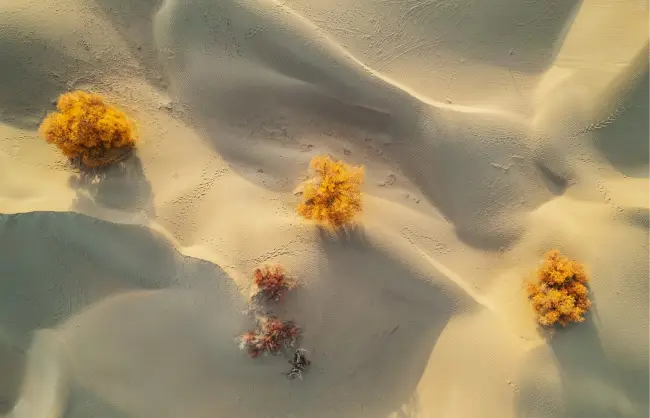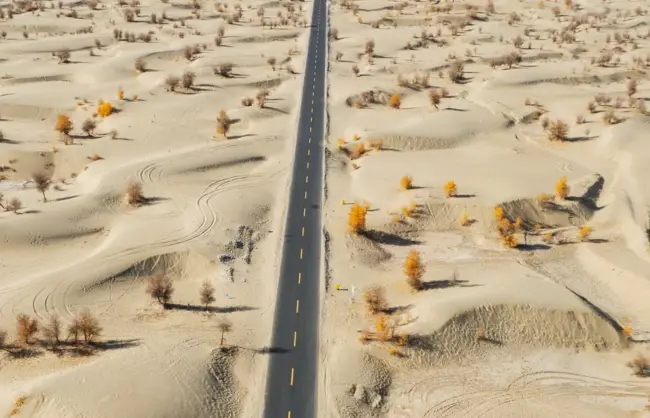The size of the Taklamakan Desert is 330,000 square kilometers, which is 20% of Xinjiang’s land area and is equal to the total area of 50 cities as big as Shanghai. It is 1,000 kilometers from east to west and 400 kilometers from north to south. Inside, pyramid-shaped sand dunes stand as tall as 300 meters, and wailing winds can push these walls of sand even farther.
The dunes are relentless, forever advancing with the wind. The world’s tenth largest desert and the world’s second largest moving dune desert after the Arabian Peninsula’s Rub’ al Khali, the Taklamakan Desert is simply nicknamed the “Sea of Death,” the world’s second-largest non-polar dune desert.
Its name, “Taklamakan,” is possibly from the Uyghur language, meaning “you can go in, but you can’t get out,” or some say it’s Turkish for “land of ruins.” It was in this inhospitable terrain that the karez irrigation system was created, a testament to humankind’s ingenuity for surviving such a brutal land.
Facts About the Taklamakan Desert
- Location: Southwest Xinjiang, Northwest China; Center of Tarim Basin.
- Area:330,000 square kilometers.
- Type:Desert, Geologic Formations.
- Best Time:Late October to Mid-November.
- Suggested Visiting Duration:1-2 days.
- Opening Time:Throughout the Day.
Where is the Taklamakan Desert
The Taklamakan Desert is located in the center of the Tarim Basin in Xinjiang, northwestern China. Visualize it extending from Korla in the east, where it borders the Gobi Desert, all the way to the west near Kashgar, just by the Pamir Plateau (not touching but close by).
Look at a Taklamakan Desert map, and you’ll see the southern portion hugged by the Kunlun Mountains, with the north stretching out to Aksu, facing the Tianshan Mountains. It’s a huge, breathtaking desert landscape, enclosed by nature’s own walls. And, of course, we’re talking about the Taklamakan Desert here, a place like no other.
√Related reading: Top 6 Deserts in China

History of Taklamakan Desert
The origin of the Taklamakan Desert’s name has been a subject of historical controversy. It wasn’t until recently that the Taklamakan Desert was officially given its vibrant name by the Uyghur people. “Takla” is a word in the Uyghur language that implies “beneath” or “place of beginning,” while “Makan” implies “dwelling” or “spot.” Together, they mean “the dwelling beneath the desert” or “place of beginning,” which describes the historical status of the Taklamakan Desert of China.
The origins of the Taklamakan Desert are directly linked to tectonic activity. It is a land created by the fierce collision of the South Asian subcontinent and the Eurasian Plate. The collision uplifted the Himalayas and the Tibetan Plateau and formed huge fold mountains like the Kunlun and Tianshan.
The basin is blanketed by a deep layer of continental sediments of over ten thousand meters in depth. These sediments, eroded by relentless winds, gather, move, and stack up to form boundless shifting dunes and, finally, the Taklamakan Desert. It is a land where the people of the Taklamakan Desert have lived and thrived amidst the sands.
Physiography of Taklamakan Desert
China’s Taklamakan Desert is a place of geomorphological surprises, with its magnificent mountain and dune landscapes predominant.
There are suddenly small hills and chain-like mountain ranges within the great desert, made up of Cenozoic sandstone and clay, among which the Mazartag Mountains and Rostag Mountains are most prominent. While the mountains are not high, they make the Taklamakan Desert rugged and stratified. Their surfaces are overlain by thin layers of weathered material and rock fragments, and scattered vegetation marks the general features of the desert.
Moreover, the Taklamakan Desert is famous for its wide, never-ending dunes. These dunes, formed from loose alluvial deposits by weathering, hold windblown sand layers as deep as one thousand feet. They come in all sizes and shapes, ranging from heights of a few dozen meters to over a hundred meters, and lengths from hundreds to thousands of meters.
These dunes are in a constant state of flux under the hand of the wind and create a dramatic aeolian landscape. For those who are asking the location of Taklamakan Desert, you can find it covering parts of China. These dunes not only add to the landscape of the Taklamakan Desert but also draw in tourists and adventurers from all over the world, making it a destination that needs to be visited.
Taklamakan Desert Climate
The Taklamakan Desert is one where the climate is really different as it has an extreme continental climate. The annual precipitation is very little, from 38 millimeters in the west to as low as 10 millimeters in the east, while evaporation amounts to 2,500 to 3,400 millimeters a year, making the desert very dry. The summer temperature of the Taklamakan Desert hits a scorching 67.2℃, and the diurnal temperature range is more than 40℃, which is almost unbearable.
Yet winter brings its own issues, with January temperatures -9 to -10℃ and lows often below -20℃. Then there’s the sand and wind of the Taklamakan Desert, something else entirely, created by the combination of northerly and northwesterly winds.
Over 80% of the land is made up of mobile dunes. Spring is particularly susceptible to strong northeast winds, which can spark awful sandstorms, sending dust to heights of 3,962 meters and above.
And by the time summer comes, the western part of the Taklamakan Desert is mostly influenced by the northeast and northwesterly winds, developing a complex circulation system. It is interesting to note here that as much as the desert is scorching hot, it has also seen sporadic Taklamakan Desert snow, which presents a very stark contrast to the dry, barren landscape.
Related reading: Top 12 Things to Do in Xinjiang

Plant and Animal of Taklamakan Desert
The Taklamakan Desert is completely different in its flora and fauna.
For plants of the Taklamakan Desert, the majority of the desert is blanketed by moving sand dunes, and it’s hard for plants to exist.
Yet, in the dune troughs, where groundwater is nearer the surface, you might be able to spot some poplars, saltbush, and reeds. Closer to the Taklamakan Desert’s edge, where dunes yield to river valleys and deltas, vegetation rises as a result of groundwater being nearer. Here, not only poplars and reeds but even riverbank specialty vegetation like the Turkish poplar, olive, camel thorn, cotton legumes, and salt-loving vegetation grow.
When it regards animals of the Taklamakan Desert, the landscape is stark and barren. Only on the fringes of the desert, especially in old and new river valleys and deltas, vegetation and water support a variety of animals. Gazelles and wild boars live in these locations, along with predators like wolves and foxes.
In the open desert, though, animal species drop off precipitously. Even the Taklamakan Desert once had tigers, though they’re gone now. Between the dunes, rabbits and sand rats thrive, along with insectivores like long-eared hedgehogs and bats. And among birds, the tiny fluff lark and Tarim jay are the stars, scratching out a existence in this unforgiving land.
Efforts are also being made to create a Taklamakan Desert Green Wall and construct Taklamakan Desert Oasis to further protect this unusual ecosystem.
Taklamakan Desert and the Silk Road
The Taklamakan Desert is at the heart of the Silk Road. It lies on a vital part of the Silk Road, an old path that was initiated with Zhang Qian’s Western Han Dynasty journey to the West.
This made it a main route for trade and cultural exchange between East and West.
Imagine merchants on camel backs crossing the endless dunes of the Taklamakan Desert, carrying silk, tea, and other products to places like Central Asia, the Middle East, and Europe. In return, they brought back treasures like glassware and spices.
There are Han and Tang ruins, big city ruins, and the famous Niya site in the desert, all testifying to this great history. Besides, the natural environment of the Taklamakan Desert played an important part in Silk Road culture and trade. Postal roads along the two sides of the desert linked with Central Asian, West Asian, and South Asian roads to make up a whole system of the Silk Road. This helped in carrying goods and mixed Eastern and Western civilization.
Because of this, the Taklamakan Desert acted as a bridge between China, Egypt, Babylon, India, and European countries like Greece and Rome. It’s a must-stop for China silk road tour, especially when considering the Silk Road and Taklamakan Desert shared history.
What to See and Visit in Taklamakan Desert
There pass the G216 and G217 highways, very significant lifelines that slice through the Taklamakan Desert and are major routes for adventurers brave enough to traverse this harsh landscape. The highways offer adventurers and travelers the possibility of traversing the Taklamakan Desert.
Luntai-Minfeng Desert Highway
It is about 580 kilometers in length, a 9-hour drive. Since there are limited hotels along the way, it is best to reserve a one-day Xinjiang tour. Minfeng County is gaining popularity because of the Qingque Ancient City ruins, where tourists can see precious artifacts from the Niya ruins at the local museum.
Aral Hotan Desert Highway
The highway is 440 kilometers long, and the drive takes approximately 6 hours to complete. Two hours or so after leaving Luntai, you’ll enter the Alar Desert Highway of the Taklamakan Desert, where villages, people, and livestock are scarce, with nothing but endless sands to be company in your Xinjiang travel.
How to Get to Taklamakan Desert
Visiting Rob People Village
- Take a flight (1 hour) or train (4-5.5 hours) from Urumqi to Korla.
- From the downtown of Korla, hire a private car to Rob People Village (80 km, 2-hour driving).
Traveling the Desert Highway (G3012) across Taklamakan Desert:
- Start in Aksu, Kuqa, or Luntai, key Silk Road cities.
- Fly from Urumqi to Kuqa (1 hour) or Aksu (1.5 hours), or take the train to Aksu (9.5-11.5 hours) or Kuqa (7.5-9.5 hours).
- Spend the first night in Aral, then drive through Taklamakan Desertto Hotan via G217 the next day.
- Or fly from Urumqi to Hotan (2 hours) and return by car to Aral.
Taking the Second Desert Highway (G216) through Taklamakan Desert
- Start from Luntai or Mingfeng.
- No direct flights. Train from Urumqi to Luntai (7.5-8 hours) or drive via G3012 through Turpan and Korla.
- Another choice: Drive from Hetian to Mingfeng (290 kilometers, 5.5 hours) via G315, with good scenery through Taklamakan Desert.









